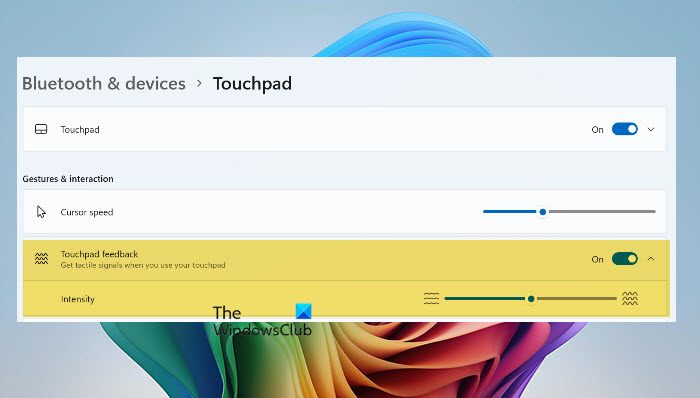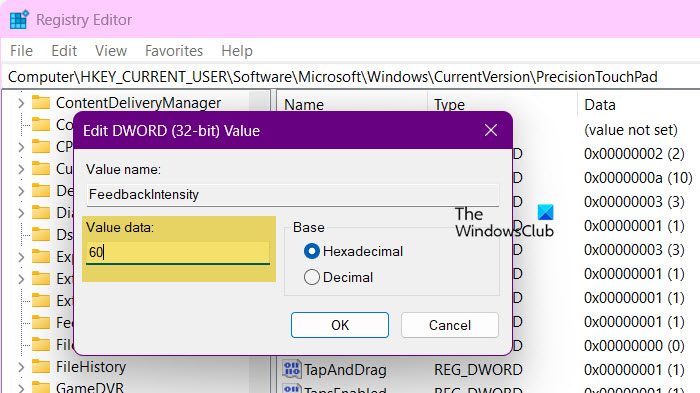Microsoft has introduced Haptic touchpad feedback to Ssurface laptops to enhance the user experience and give some more functionality. In this post, we will discuss how to configure haptic touchpad feedback on Surface laptops.
The haptic motors in the Surface Precision Haptic touchpad provide tactile feedback, simulating physical clicks or taps, even though the touchpad does not move. This delivers a more intuitive and immersive experience while using a Surface device.
To configure haptic touchpad feedback on your Surface laptops, use one of the below-mentioned features.
- Enable or disable the Haptic touchpad and set its intensity from Windows Settings
- Enable or disable the Haptic touchpad and set its intensity from Registry Editor
Let us talk about them in detail.
Turn on or off Haptic touchpad feedback and set its intensity from Windows Settings

First, let’s see how to turn on or off Haptic touchpad feedback from Windows Settings. To do so, follow the steps mentioned below.
- Open Settings by Win + I.
- Now, go to Bluetooth & devices > Touchpad.
- Scroll down to reach Gestures & interaction and then enable Touchpad feedback.
- While you are there, use the Intensity slider to set how much feedback you should be getting.
Once you are done configuring the slider, we can close Settings.
Please keep in mind that enabling touchpad feedback can reduce your battery life. We recommend keeping it off whenever you are in a crunch and want to save your precious battery life, but if you are connected to a power source or are near one, feel free to enable it and enjoy this feature.
Enable or disable Haptic touchpad feedback and set its intensity using the Registry

The changes you made in Settings only apply to an individual user, but if you want to sync this setting across multiple users connected to your domain, you need to run a registry script to make changes to the registries.
However, before mortifying the registry, it is recommended to take a backup of your Registry Editor. This backup can be used to restore the registries to their previous state.
Once you have created the backup, open Notepad, and paste the following scripts into different files.
To enable haptic feedback, use the following script.
Windows Registry Editor Version 5.00 [HKEY_CURRENT_USER\Software\Microsoft\Windows\CurrentVersion\PrecisionTouchPad] "FeedbackEnabled"=dword:ffffffff
To disable haptic feedback, use the script mentioned below.
Windows Registry Editor Version 5.00 [HKEY_CURRENT_USER\Software\Microsoft\Windows\CurrentVersion\PrecisionTouchPad] "FeedbackEnabled"=dword:00000000
All you have to do is, save the script to any location, give it a name but with .reg extension, and then run it.
You can also set the intensity of the feedback using the Registry Editor. Follow the steps given below.
Open Registry Editor.
Go to –
HKEY_CURRENT_USER\SOFTWARE\Microsoft\Windows\CurrentVersion\PrecisionTouchPad
Look for FeedbackIntensity and set its value from 0 to 100. If it’s not there, create a DWORD value and name it FeedbackIntensity.
Finally, reboot your computer and the changes will be applied.
Read: How to enable or disable Tablet PC touch input in Windows
How do I change my touchpad settings on Windows?
To change your touchpad settings on Windows, you need to make use of the Settings app. So, open Settings by Win + I, go to Bluetooth & devices > Touchpad, and then make the changes to your touchpad settings.
Read: How to change Touchpad Sensitivity in Windows?
How do I enable my touchpad in settings?
Touchpad is usually enabled by default, but if you have somehow disabled it, we can enable it back from Settings. Open Settings and navigate to Bluetooth & devices > Touchpad. Now, enable the Touchpad toggle.
Also read: TouchPad not working on Windows.
Leave a Reply